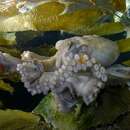Comprehensive Description
provided by Smithsonian Contributions to Zoology
Octopus asper (Akimushkin, 1963)
DIAGNOSIS.—Animal medium-sized to large (312–770 mm TL). Mantle pyriform, relatively narrow (MWI 65–84); head narrow. Funnel short, funnel organ W-shaped, outer limbs shorter than inner ones. Arm length moderate (ALI 72–77), thick basally, arm formula typically II > I > III > IV. Sucker size large (SIn 11.0–15.8); especially enlarged suckers absent in males and females; ASC 220–240. Right arm III of males hectocotylized, shorter than fellow arm (FAI ∼67); ligula moderate in length (LLI 12.5 in mature specimen), slender, tapered distally, medial groove distinct; calamus minute. Web moderate (WDI 20–27), web formula usually C > D > B > A > E. Gill lamellae 13. Penis long (to 40 mm), narrow. Radula with A3 seriation of rachidian. Surfaces of mantle, head, base of arms, and web densely covered with circlets of papillae comprised of 1 large central papilla surrounded by smaller ones, most numerous between eyes and at base of arms; 1 large or 2 to 3 small supraocular papillae, 2 papillary rows extended along lateral region of mantle and head. General color in preservation violet brown dorsally, lighter brown ventrally.
ORIGINAL DESCRIPTION.—Akimushkin, 1963:138, figs. 28, 29, as Paroctopus asper.
TYPE LOCALITIES.—Western North Pacific Ocean, Kamchatka Peninsula to northern Sea of Japan.
TYPES.—Syntypes: Not deposited, 5 males, 312–770 mm TL, 2 females, 475 mm TL, 662 mm TL, no longer extant (see “Discussion”).
DISTRIBUTION.—Known only from the type localities.
- bibliographic citation
- Voss, N. A. and Sweeney, M. J. 1998. "Systematics and Biogeography of cephalopods. Volume II." Smithsonian Contributions to Zoology. 277-599. https://doi.org/10.5479/si.00810282.586.277

